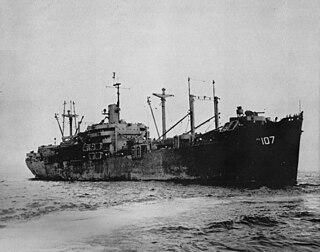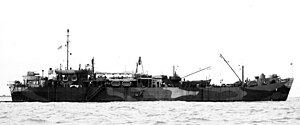Service history
Following shakedown in Chesapeake Bay, Oceanus departed Norfolk, Virginia on 23 July 1943 for the Pacific, arriving at Nouméa, New Caledonia 18 September. She remained there, converting LCIs to shoal-draft gunboats and making emergency repairs to damaged vessels. On 28 October, she shifted to Espiritu Santo, thence, departing on 1 July 1944, to Florida Island. On 9 September 1944, she departed the Solomon Islands in TG 31.4 and on 20 September, arrived at Kossol Roads, Palaus. There she repaired, often while underway, craft and vessels damaged in the assaults against those islands and against the Philippines. In February 1945, she steamed to Guam to join TG 51.5 for the Iwo Jima invasion, arriving on 20 February, and remaining until 17 March.
The Okinawa campaign next took Oceanus to Kerama Retto, where work on ships damaged by kamikazes and bombs kept her on a round-the-clock schedule into mid-May. On 14 May, she shifted to the Hagushi anchorage for emergency repairs to the battleship New Mexico. Completing the work and returning to Kerama Retto's "Scrap Iron Row" on 21 May, she remained until early June when she steamed to the Philippines.
Arriving at Leyte 15 June, she remained in San Pedro Bay until after the end of the War.

USS Anzio (ACV/CVE/CVHE-57), was a Casablanca-class escort carrier of the United States Navy that saw service during World War II in the Pacific War. Originally classified as an auxiliary aircraft carrier ACV-57, the vessel was laid down in 1942, in Vancouver, Washington, by the Kaiser Shipbuilding Company and initially named Alikula Bay, then renamed Coral Sea and redesignated CVE-57 in 1943. Coral Sea took part in naval operations supporting attacks on the Gilbert and Marshall Islands, New Guinea and the Marianas Islands. In September 1944, she was renamed Anzio. As Anzio, the escort carrier took part in assaults on the Bonin Islands and Okinawa. Following the cessation of hostilities in 1945, Anzio was among the escort carriers used in Operation Magic Carpet, returning US soldiers to the United States. Following this service, she was laid up in reserve at Norfolk, Virginia, in 1946. The escort carrier was redesignated CVHE-57 on 15 June 1955, before being sold for scrap in 1959.

USS Hutchins (DD-476), was a Fletcher-class destroyer, of the United States Navy named after Naval aviator Lieutenant Carlton B. Hutchins (1904–1938), who though mortally injured, was able to remain at the controls of his aircraft and allow his surviving crew to parachute to safety and was posthumously awarded the Medal of Honor.

USS Munsee (AT/ATF-107) was an Abnaki-class fleet ocean tug. She is the only ship of the United States Navy to hold the name Munsee, which is the name of a subtribe of the Delaware Indians, still living in Wisconsin and Kansas.

USS Grumium (AK-112/IX-174/AVS-3) was a Crater-class cargo ship and aviation supply ship in the service of the US Navy in World War II. Named after the star Grumium in the constellation Draco, it was the only ship of the Navy to bear this name.

USS Hopping (DE-155) was a Buckley-class destroyer escort in service with the United States Navy from 1943 to 1947. In 1944, she was converted to a Charles Lawrence-class high speed transport and redesignated "APD-51". She was sold for scrap in 1966.

USS Nestor (ARB-6) was planned as a United States Navy LST-491-class tank landing ship, but was redesignated as one of twelve Aristaeus-class battle damage repair ships built for the United States Navy during World War II. Named for Nestor, she was the only US Naval vessel to bear the name.
USS Aristaeus (ARB-1) was planned as a United States Navy LST-1-class tank landing ship, but was redesignated as one of twelve Aristaeus-class battle damage repair ships built for the United States Navy during World War II. The lead ship in her class, she was named for Aristaeus, the only US Naval vessel to bear the name.

USS Phaon (ARB-3) was planned as a United States Navy LST-1-class tank landing ship, but was redesignated as one of twelve Aristaeus-class battle damage repair ships built for the United States Navy during World War II. Named for Phaon, she was the only US Naval vessel to bear the name.

USS Midas (ARB-5) was planned as a United States Navy LST-491-class tank landing ship, but was redesignated as one of twelve Aristaeus-class battle damage repair ships built for the United States Navy during World War II. Named for Midas, she was the only US Naval vessel to bear the name.

USS Sarpedon (ARB-7) was laid down as a United States Navy LST-542-class tank landing ship but was converted as one of twelve Aristaeus-class battle damage repair ships built for the Navy during World War II. Named for Sarpedon, and also she was the only US Naval vessel to bear the name.
USS Telamon (ARB-8) was planned as a United States Navy LST-542-class tank landing ship but was converted as one of twelve Aristaeus-class battle damage repair ships built for the Navy during World War II. Named for Telamon, she was the only US Naval vessel to bear the name.

USS Ulysses (ARB-9) was planned as a United States Navy LST-542-class tank landing ship, but was redesignated as one of twelve Aristaeus-class battle damage repair ships built for the United States Navy during World War II. Named for Ulysses, she was the second US Naval vessel to bear the name.

USS Egeria (ARL-8) was one of 39 Achelous-class landing craft repair ships built for the United States Navy during World War II. Named for Egeria, she was the only U.S. Naval vessel to bear the name.

USS Robin was a YMS-1-class minesweeper of the YMS-135 subclass built for the United States Navy during World War II.

USS LST-900 was an LST-542-class tank landing ship in the United States Navy during World War II. Late in her career, she was renamed Linn County (LST-900)—after counties in Iowa, Kansas, Missouri, and Oregon—but saw no active service under that name.
USS Spectacle (AM-305) was a steel-hulled Admirable class minesweeper built for the U.S. Navy during World War II. A trained crew boarded the new vessel, practiced with her minesweeping gear, and then proceeded to the Pacific Ocean to clear mines from Japanese beaches so that Allied forces could invade. While performing this dangerous task of mine clearance, a Japanese plane strafed her, and another deliberately crashed into her. When she returned to the United States, her battle damage was so severe that the U.S. Navy decided to scrap, rather than to repair, her. She was awarded two battle stars.

USS Riddle (DE-185) was a Cannon-class destroyer escort in service with the United States Navy from 1943 to 1946. In 1950, she was transferred to France where she served as Kabyle (F718) until being decommissioned and scrapped in 1959.
USS Recruit (AM-285) was an Admirable-class minesweeper built for the United States Navy during World War II. She was awarded 3 battle stars for service in the Pacific during World War II. She was decommissioned in August 1946 and placed in reserve. While she remained in reserve, Recruit was reclassified as MSF-285 in February 1955 but never reactivated. In 1963, she was sold to the Mexican Navy and renamed ARM DM-07. Although she is reported out of service, her ultimate fate is not reported in secondary sources.

USS Goodhue (APA-107) was a Bayfield-class attack transport in service with the United States Navy from 1944 to 1946. She was sold into commercial service in 1947 and was scrapped in 1982.

USS Natrona (APA-214) was a Haskell-class attack transport of the US Navy in World War II. She was of the VC2-S-AP5 Victory ship design type. Natrona was named for Natrona County, Wyoming.
















